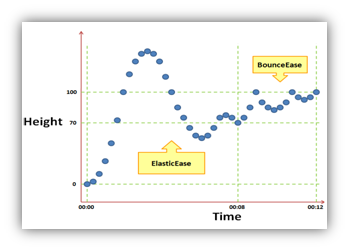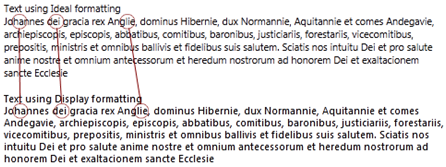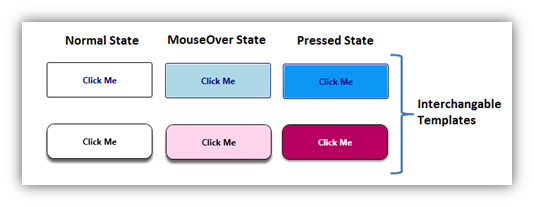WPF 4 (VS 2010 and .NET 4.0 Series)
[In addition to blogging, I am now using Twitter for quick updates and to share links. You can follow me on Twitter at: twitter.com/scottgu (@scottgu is my twitter name)]
This is the eleventh in a series of blog posts I’m doing on the upcoming VS 2010 and .NET 4 release. Today’s post covers WPF 4.
WPF 4 Improvements
WPF (Windows Presentation Foundation) is one of the core components of the .NET Framework, and enables developers to build rich, differentiated Windows client applications. WPF 4 includes major productivity, performance and capability improvements – in particular in the areas of Controls, XAML, Text, Graphics, Windows 7 integration (multitouch, taskbar integration, etc), Core Fundamentals, and Deployment. This is the first of several posts I’ll do over the coming months about some of the improvements and new features.
I will do a separate post soon that covers some of the major advances coming with VS 2010’s WPF and Silverlight Designer – which also includes a ton of improvements.
Controls
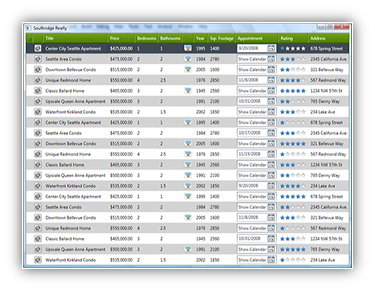 Controls for Building Rich Clients
Controls for Building Rich Clients
WPF 4 adds a variety of new controls that make building rich line-of-business applications for the client easier and faster. The new, richer control set includes LOB essentials such as DataGrid, DatePicker, and Calendar controls. These new controls are 99% API- and behaviorally-compatible with their Silverlight counterparts, enabling developers to create a consistent experience across the client and web while optimizing workflow by reusing code between Silverlight and WPF implementations.
Bag O'Tricks is back
We are also releasing an out-of-band collection of eight controls called the WPF Bag O’ Tricks download. It includes the following controls: AnimatingTilePanel, ColorPicker, InfoTextBox, ListPager, NumericUpDown, Reveal, TransitionsPresenter, TreeMapPanel.
Windows 7 & Office Ribbon Control
A new WPF Ribbon Control will be available for download shortly after the release of WPF 4. It features skins for Windows 7 and Office, as well as all the standard Ribbon features that end-users are familiar with, including tabs and groups, dynamic resizing, quick access toolbar, application menu, contextual tabs, key tips, and more.
The WPF Ribbon will be fully extensible to meet changing guidelines for future releases. A CTP with a limited feature set is available today here
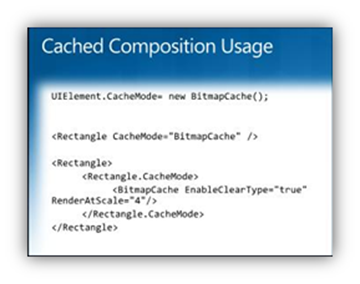 GRAPHICS
GRAPHICS
Cached Composition
Massive performance wins are possible with the new Cached Composition feature in WPF 4, which allows applications to cache arbitrary content including live and fully-interactive controls, vector geometry, etc. as bitmaps which persist in video memory. Once cached, these elements can be arbitrarily transformed, animated, manipulated, and can have Effects applied, all without having to re-render the cached element.
This spares both the CPU and the GPU the cost of re-rendering content, and instead allows the GPU to render straight from the cache. The cache(s) understand dirty regions, so a blinking cursor in a cached textblock, for example, will only need to re-render the cursor between frames. There’s even a new Brush which specifically uses these intelligent caches – effectively a VisualBrush with vastly better performance.
Pixel Shader 3 Support
WPF 4 builds on top of the very popular ShaderEffect support first introduced in WPF 3.5 SP1 by allowing applications to now write Effects using Pixel Shader version 3.0. The PS 3.0 shader model is dramatically more sophisticated than PS 2.0, allowing for even more compelling Effects on supported hardware.
LayoutRounding
WPF 4 adopts the UseLayoutRounding property, originally introduced in Silverlight 2. WPF’s layout engine frequently calculates sub-pixel positioning coordinates. This can lead to rendering artifacts as elements positioned on sub-pixel boundaries are anti-aliased over multiple physical pixels.
UseLayoutRounding will force the layout engine to place elements on whole pixel boundaries, thus removing most of the rendering artifacts caused by this problem – which generates cleaner and crisper UI by default.
Discrete, linear, and spline animations were supported with previous versions of WPF. WPF 4 introduces a new concept of Easing Functions – which allows application authors to create fluid behavior using animations. This can be used in an infinite number of ways, such as creating a springy behavior, or adding anticipation to an animation. Easing Functions customize the manner in which animations progress from start to finish. The built-in easing functions provide a range of behaviors such as circular, exponential, elastic, and bouncy animation progress. The extensibility design also allows application authors to create custom easing functions to define the manner in which their animations progress. With this easy-to-use feature, designers can effortlessly create fluid, organic animations.
CleartypeHint
The new CleartypeHint attached property allows application authors to enable higher-quality Cleartyped text rendering in many situations where it would have previously been disabled. Such situations include text in layered windows, text in VisualBrushes, DrawingBrushes, BitmapCacheBrushes, and anywhere else where the introduction of an intermediate render target would have previously resulted in grayscale text rendering.
TEXT STACK
New Text Rendering Stack
The WPF text rendering stack has been completely replaced – a change that brings with it significant improvements to text rendering clarity, configurability, and support for international languages. The new text stack now supports display-optimized character layout, to produce text with comparable sharpness to Win32/GDI text:
WPF’s new text stack also now supports explicitly selecting aliased, grayscale, or ClearType rendering modes:
The new text stack allows optimizing text hinting and snapping for either animated or static text. Additionally, the new text stack now supports fonts with embedded bitmaps. This allows many East Asian fonts to render with the sharpness to which Win32 users have grown accustomed.
BindableRun
Since the initial release of WPF, Run.Text has been a normal CLR property. This has meant that Run.Text lacks all the benefits of the WPF dependency property system, most notably the ability to be bound. In WPF 4, we have converted Run.Text to a dependency property allowing developers to use the first WPF supplied bindable Run. More details can be found here.
Custom Dictionaries
WPF includes a spell checker which before WPF 4 only used the OS-provided dictionary for input validation. This has been a major issue for apps which target specific industries with specialized terminology, as those apps were plagued by misspelling notifications. WPF 4 has introduced an API to allow an application to add words to the dictionaries used by WPF for spell checking. More details can be found here.
Selection and Caret Brush
In a push to allow rich customization of the look and feel of WPF apps, developers can also now change the brush used to paint WPF text selection and carets via two simple properties: SelectionBrush and CaretBrush:
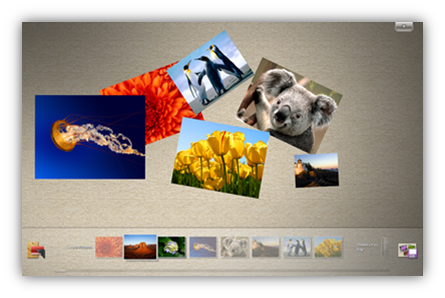 WINDOWS 7 LIGHT UP
WINDOWS 7 LIGHT UP
Windows 7 Multitouch Support
With the introduction of multi-touch input and manipulation processing support, WPF 4 provides a great way to light up your client applications in Windows 7. Multiple finger input are exposed through existing and new input events in WPF 4, while new manipulation and inertia events are now available for developers to use. New features include:
- Multi-touch Manipulation, Inertia (Pan, Zoom, Rotate) events on UIElement
- Raw multi-touch events (Up, Move, Down) on UIElement, UIElement3D and ContentElement
- Multiple capture supporting multiple active controls
- ScrollViewer enhancement to support multi-touch panning
- Touch device extensibility
- Future Surface SDK compatibility
Windows 7 Shell Integration
WPF 4 also exposes several new and key Windows 7 Shell features to WPF developers. These Shell features enable a richer, integrated user experience. The new taskbar is less cluttered and can convey more information at a glance. The Aero thumbnails support user commands. Jump lists provide access to contextual startup tasks and files available to the application.
WPF 4 integrates Windows 7 Jump List functionality, including:
- Tasks
- Items
- Recent and Frequent Lists integration
- Custom Categories
Windows 7 Taskbar integration, including:
- Progress bar
- Overlay Icon
- Thumbnail buttons with commanding support
- Description Text DWM Thumbnail clipping
In Windows 7, the taskbar has been redesigned to be less cluttered and to help users perform tasks with fewer clicks. WPF 4 provides integration with the Windows 7 taskbar in XAML, allowing applications to surface useful information to the user from the application's taskbar icon using icon overlays, progress bar, thumbnail toolbars, thumbnail description text, and thumbnail clipping.
There is also a new TaskbarItemInfo class in WPF 4 that is exposed as a dependency property. It encompasses all the new taskbar features introduced in Windows 7.
Icon overlays allow an application to communicate certain notifications and status to the user through its taskbar button by display of small overlays which appear at the lower-right corner of the button.
Progress Bars
A taskbar button can be used to display simple progress information to the user without that user having to switch to the application window itself. Progress bars can be used to track file copies, downloads, installations, media burning, or any other operation that will take a period of time.
Thumbnail Toolbars
Thumbnail Toolbars provide access to the key commands for an application without the user having to restore or activate the window. This feature enables application authors to embed an active toolbar control in a window's thumbnail preview. The application can show, enable, disable, or hide buttons from the thumbnail toolbar as required by its current state:
WPF FUNDAMENTALS
New XAML/BAML Parser Engine
WPF 4 has replaced its implementation of XamlReader.Load(), BAML loading, Control & DataTemplates functionality with a new engine built on top of the new System.Xaml.dll. As part of this effort, we’ve fixed many bugs and made many functionality improvements. Users of XamlReader.Load() can take advantage of several new language features in XAML2009 such as support for generic types. MarkupExtensions and TypeConverters can now get more services during object graph creation, enabling more scenarios, such as access to the Root object. Tools to analyze and manipulate XAML will also be much easier to create with many of the new low level APIs provided in System.Xaml.dll.
Data Binding Support for DLR
Unlike CLR classes, the members of dynamic objects are defined at runtime. DynamicObject is a new abstract class in the .NET Framework 4 that allows developers to easily implement IDynamicMetaObjectProvider. With C#’s new DLR support with the ‘dynamic’ keyword, we are expecting some library implementations to switch to using DynamicObject and IDynamicMetaObjectProvider as a standard way to exposing runtime defined properties and members of objects. WPF 4 data binding support for IDynamicMetaObjectProvider will allow the use of natural property syntax to access dynamic properties.
This feature extends the WPF data binding engine to map the existing property and indexer access data binding syntax to support access to dynamic members offered by IDynamicMetaObjectProvider.
Visual State Manager (VSM)
Another new feature supporting the WPF-Silverlight continuum is the VisualStateManager, which introduces a simple new way to apply visual states to controls. This mechanism provides a way to easily customize both the look and feel of a control by providing the means to map the control logic to its respective start and end visual states.
VSM is very flexible in that it automatically generates the transition animations in between the respective states, so the control author spends less time writing code and more time on the visual states that are defined in a control template. That means VSM can give a control author the ability to easily interchange the look and feel of controls, and VSM gives the control author a way to easily interchange how a control visually responds to user interaction. This is fully supported with Expression Blend.
HTML-XBAP Script Interop
WPF 4 provides the means for direct communication between an XBAP and script in the host HTML page (where the XBAP is loaded in an HTML frame or IFRAME element). The XBAP can get deep access to the HTML DOM, including to any ActiveX controls embedded in the containing HTML page and including handling of DOM events.
WPF exposes the main script object from the host frame. This is a dynamic object that represents the frame’s window object plus any custom script functions and global variables from script in the HTML page. From it, an application can invoke script functions directly or “dot into” the HTML DOM. The functionality is available in partial-trust XBAPs and under all supported versions of Internet Explorer and Firefox.
UIAutomation Virtualization
WPF has introduced virtualized controls in past releases; however there was never a standardized way for an automation client to interact with a virtualized control. Two control patterns, ItemsContainerPattern and VirtualizedItemPattern, have been added in WPF 4 to support access and interact with virtualized elements. ItemsContainerPattern is used to access the virtualized controls & find virtualized items and VirtualizedItemPattern is used to realize virtualized items.
SynchronizedInput Pattern
This is another UIA control pattern added in WPF 4. This pattern could be used by automation clients to track whether the given input event is routed to the correct element by WPF framework. This pattern has three associated automation events, viz. InputReachedTargetEvent, InputReachedOtherElementEvent and InputDiscardedEvent to indicate where the input is handled.
CLIENT DEPLOYMENT
.NET Framework 4 Client Profile
To improve deployment size, time and overall experience of the .NET Framework 4 deployment, there is now a more compact version of .NET that is a subset of the full .NET Framework 4 - called the .NET Framework 4 Client Profile. The current redistributable size of the .NET Framework 4 Client Profile is about 30MB. The full Microsoft .NET Framework 4 is a pure superset of the Client Profile.
The goal of the .NET Framework 4 Client Profile is to improve and help streamline the deployment size, time, reliability and overall deployment experience for client applications. The Client Profile contains the functionality that most common desktop client applications (including Windows Forms and WPF applications) would need so it is anticipated that the majority of client application developers will target it instead of the Full .NET Framework 4. For that reason, most Visual Studio 2010 Beta 2 client project templates target the .NET Framework 4 Beta 2 Client Profile by default.
Unlike the .NET Framework 3.5 SP1 Client Profile, an important enhancement in the NET Framework 4 Client Profile is its support on all platforms and OSs, including those supported by the Full Framework like Windows Vista, Windows XP, Windows Servers 2003 and 2008, Windows 7, all for both x86 and x64.
You can view or change the version of the framework that you target by opening your project’s properties window, and then select the "Application" page. You can then change the “Target framework” drop-down to either the full .NET Framework or the .NET Client Profile. The project Publish property page also allows you to select the prerequisite needed for your ClickOnce deployment. In Beta2, VS2010 automatically selects the correct profile (Client Profile or Full) depending on your primary project target:
The same prerequisite dialog from above appears when you create “Setup and Deployment” projects (under “Add New Project”/“Other Project Types”). The NET4 Client Profile prerequisite entry is checked by default in this case.
Enhancements in NET4 Client Profile vs. NET 3.5 SP1 Client Profile
Although the concept of a Client Profile is not new and was introduced in .NET Framework 3.5 SP1, the .NET Framework 4 Client Profile contains several important improvements:
| .NET Framework 4 Client Profile (NEW) | .NET Framework 3.5 SP1 Client Profile | |
| Supported OS | Supported on all platforms and OSs that are supported by the .NET Framework (excluding IA64 and the Server Core role in W2K8) | Supported only on Windows XP 32-bit machines that did not have any .NET Framework version installed. (Client Profile setup silently installs the full 3.5 SP1 Framework otherwise) |
| Redistributable | Supports redistributable as well as web download | Supports web download only |
| Add Remove Programs entries | The full Framework comprises the Client Profile and another part called “Extended”. Thus it has two entries in the Add/Remove Programs dialog (or Programs and Features window). If you installed the Full Framework, you can switch to the Client Profile by simply removing “Extended” from Add/Remove Programs. | Single entry in Add Remove Programs |
| Visual Studio | Improved support for Client Profile targeting in Visual Studio 2010. By default many Visual Studio 2010 Beta2 Client project target the NET4 Client Profile. | Single checkbox in Visual Studio 2008 Service Pack 1 “Application” Project properties for .NET Framework 3.5 projects. Client Profile support unavailable in out-of-the-box VS 2008. |
| Features | Includes new .NET 4 features (such as Managed Extensibility Framework (MEF), C# 4 Dynamic Keyword, etc) as well as features previously included in NET 3.5 SP1 Full (Speech, WPF Spell Check, etc) | Subset of features in .NET 3.5 SP1 Full |
Because .NET 4.0 is a side-by-side release from previous releases of the .NET Framework, installation of the .NET 4.0 Framework does not require that prior versions of .NET on the machine need to be serviced/patched. This means that the .NET 4.0 Client Profile installs much faster on a machine than the .NET 3.5 SP1 Client Profile.
Full Trust XBAP Deployment
Starting in WPF 4, the ClickOnce elevation prompt is also enabled for XAML Browser Applications (XBAPs) in Intranet and Trusted Zones, making it easier to deploy full-trust XBAPs. For XBAPs that require security permissions greater than the minimum code access security (CAS) permission grantset of the Intranet and Trusted Zones, the user will be able to click 'Run' on the ClickOnce elevation prompt when they navigate to the XBAP to allow the XBAP to run with the requested permissions.
Summary
As you can tell above – there is a bunch of great new functionality coming with WPF 4.0. Below are a few links and resources you can follow to learn more some of these features:
- Channel 9: Chipalo Street explains what’s new and improved in WPF 4 Text
- Chipalo also has a series of in-depth posts on the improvements in WPF 4’s new text stack.
- Channel 9: A primer on WPF 4 Graphics with David Teitlebaum
- Channel 9: Jossef Goldberg delves into what’s new in the Client Profile in .NET Framework 4
- Jossef also has detailed posts that introduces .NET 4 Client Profile and details what’s new in .NET 4 Beta 2 Client Profile
- Channel 9: Mark Wilson-Thomas demos what’s new in the Visual Studio 2010 WPF and Silverlight Designers
- and there are additional Hands on labs and videos on Windows Client.net
- Jaime Rodriguez’s highlights some of the key new features in WPF 4 and the WPF Designer in Visual Studio 2010 Beta 2
I’ll do more posts in the coming months that also highlight some of the new WPF 4 capabilities and how to take advantage of them. I’ll also be doing another post shortly that talks about the new VS 2010 WPF and Silverlight designer – which makes it possible to build great WPF and Silverlight applications using a WYSIWYG designer directly within Visual Studio 2010.
Hope this helps,
Scott

